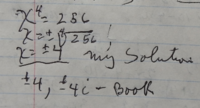allegansveritatem
Full Member
- Joined
- Jan 10, 2018
- Messages
- 962
Problem:
. . . . .49 [math]x^4\, =\, 256[/math]
What I did:
. . . . .[math]x^4\, =\, 256[/math]
. . . . .[math]x\, =\, \pm \sqrt[4]{256\,}[/math]
. . . . .[math]x\, =\, \pm 4 \qquad \mbox{(my solution)}[/math]
. . . . .[math]x\, =\, \pm 4,\, \pm 4i \qquad \mbox{(book's solution)}[/math]
What i want to know is: Where did they get that plus/munus 4i? I know that 4i to the 4th power is 256 because I used a calculator to test it but I don't know why or how this is come by.
. . . . .49 [math]x^4\, =\, 256[/math]
What I did:
. . . . .[math]x^4\, =\, 256[/math]
. . . . .[math]x\, =\, \pm \sqrt[4]{256\,}[/math]
. . . . .[math]x\, =\, \pm 4 \qquad \mbox{(my solution)}[/math]
. . . . .[math]x\, =\, \pm 4,\, \pm 4i \qquad \mbox{(book's solution)}[/math]
What i want to know is: Where did they get that plus/munus 4i? I know that 4i to the 4th power is 256 because I used a calculator to test it but I don't know why or how this is come by.
Attachments
Last edited by a moderator:


